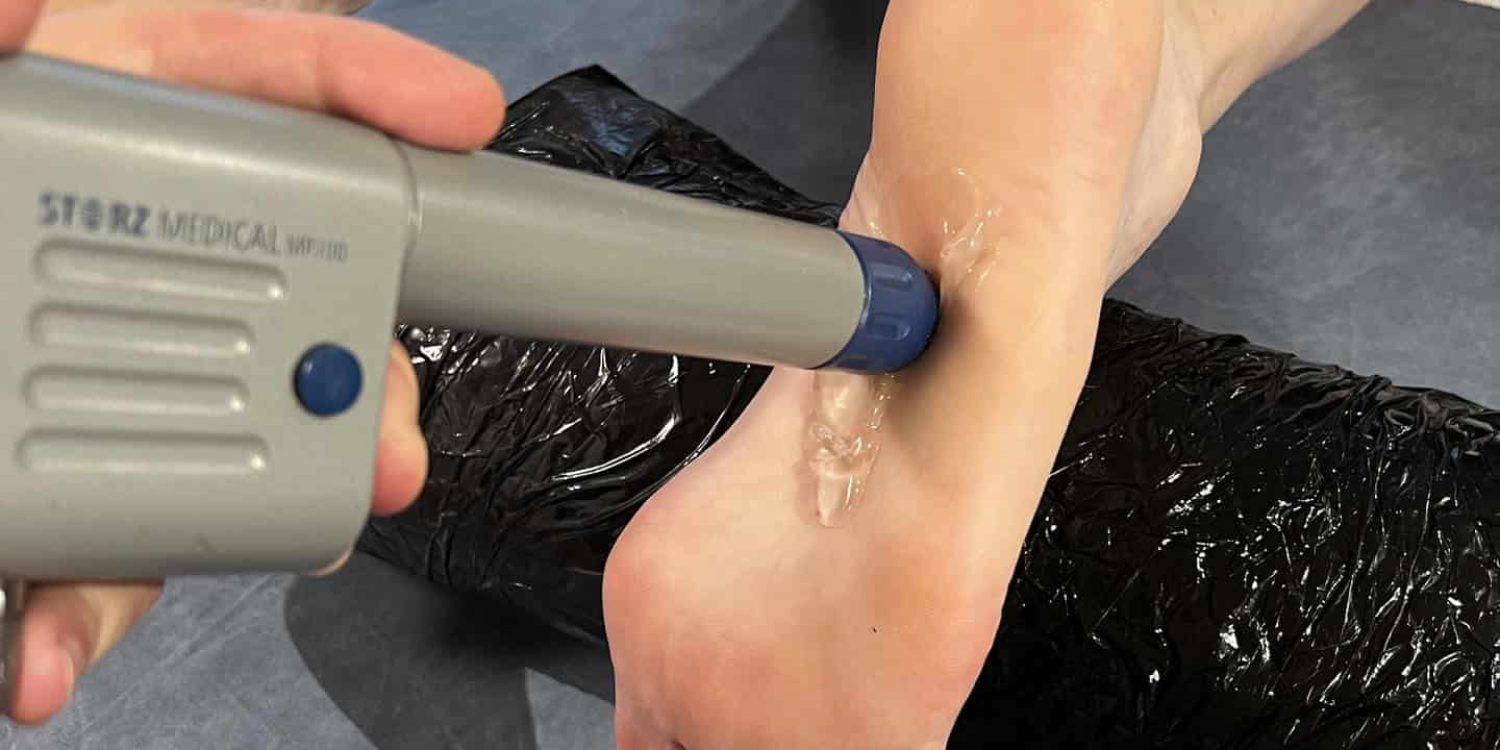Understanding the Mechanism and Benefits of Shockwave Therapy for Musculoskeletal Pain
Shockwave therapy, scientifically called Extracorporeal Shockwave Therapy (ESWT), is a revolutionary non-invasive treatment designed to address various musculoskeletal conditions. This innovative procedure employs ultrasonic waves that target specific areas of the body, particularly where connective tissues such as ligaments and tendons are affected. Shockwave therapy enhances the body's natural healing mechanisms by delivering sound waves directly to the injured site. It increases blood circulation and body pain levels and promotes tissue regeneration, making it an appealing option for many patients. This therapy is often chosen as an effective alternative to surgical interventions or prolonged use of medications, allowing individuals to experience quicker recovery times and increased comfort during the healing process.
Exploring the Comprehensive Benefits of Shockwave Therapy for Pain Relief
The advantages of shockwave therapy extend beyond mere pain alleviation, making it a compelling treatment option for those suffering from chronic musculoskeletal issues. Key benefits include:
Enhancing the Body's Natural Healing Processes
Shockwave therapy effectively stimulates the targeted tissues by transmitting sound waves, which leads to improved blood flow and heightened cellular repair activities. This process significantly enhances the body’s innate ability to heal itself, allowing damaged tissues to be repaired more efficiently and reducing the overall time required for rehabilitation.
Embracing Non-Invasive Treatment Options
A standout feature of shockwave therapy is its non-surgical nature. This characteristic allows patients to bypass the inherent risks associated with surgical procedures and the lengthy recovery periods that typically follow. As a result, individuals can return to their daily activities more swiftly without the complications often accompanying invasive treatments.
Providing Effective Pain Management
The therapeutic action of shockwave therapy can substantially reduce pain caused by various conditions. For those exploring alternatives to pharmacological treatments or invasive methods, shockwave therapy offers welcome relief, helping to manage discomfort effectively while minimizing reliance on medications.
Restoring Mobility and Enhancing Quality of Life
Patients frequently report significant improvements in their mobility following shockwave therapy sessions. By addressing the root causes of pain and stimulating the repair of damaged tissues, shockwave therapy often helps individuals move more freely and comfortably, significantly enhancing their overall quality of life.
Cost-Effectiveness Compared to Traditional Treatments
For many patients, shockwave therapy presents a more economical option than prolonged use of pain medications or surgical interventions. While costs can vary based on individual healthcare needs and insurance coverage, the potential savings make this therapy an attractive alternative for those seeking effective pain management solutions.
Minimized Side Effects and Risks
As with any medical treatment, there are inherent risks; however, shockwave therapy typically presents fewer side effects compared to surgical procedures and long-term medication regimes. Patients can enjoy the benefits of therapy with a reduced risk profile, making it a safer option for many.

Identifying Conditions Treated by Shockwave Therapy
The popularity of shockwave therapy has surged due to its versatility in treating a wide array of musculoskeletal and soft tissue disorders. This therapy has effectively addressed various conditions, improving patient outcomes and satisfaction.
Common Conditions Addressed by Shockwave Therapy Include:
Foot Conditions include painful ailments such as Plantar Fasciitis and Heel Spurs, which can significantly hinder mobility and daily activities.
Tendinopathies: These encompass conditions like Achilles Tendonitis, Tennis Elbow, and Jumper’s Knee, all of which can cause chronic pain and discomfort.
Joint Issues: Shockwave therapy is also effective for treating Stress Fractures and promoting healing in cases of delayed bone recovery.
Calcific Conditions: Patients suffering from Calcific Tendonitis, particularly in the shoulder, can benefit from shockwave therapy's pain-relieving effects.
Chronic inflammatory conditions causing persistent pain and issues relating to scar tissue and non-healing wounds can also be effectively managed with this treatment.
Exploring the Different Types of Shockwave Therapy
Electrohydraulic Shockwave Therapy (FSWT) for Targeted Pain Relief
Electrohydraulic shockwave therapy utilizes focused shockwaves to deliver targeted treatment to specific areas of pain and injury.
Ideal Applications Include:
Pain Management
Soft Tissue Injuries
Musculoskeletal Conditions
Erectile Dysfunction Treatment
Regeneration Therapy
This type of therapy promotes healing and alleviates pain by utilizing low-intensity extracorporeal shockwave therapy (ESWT). During treatment, healthcare professionals employ specialized equipment to deliver a series of low-energy shockwaves to the affected areas. These shockwaves encourage the development of new proteins and blood vessels, ensuring that the injured area receives enhanced oxygen and nutrients, thereby accelerating the healing process.
Utilizing Focused Shockwave Therapy (FSWT) with Electromagnetic Waves
Best Suited For:
Cancer Treatment
Spinal Cord Injuries
Brain Tumours
Uterine Fibroids
In medical applications, electromagnetic shockwaves are produced by an electromagnetic field and are effectively utilized in treatments like high-intensity focused ultrasound (HIFU) and radiosurgery. HIFU targets specific areas, such as the prostate or uterus, aiming to heat and destroy abnormal tissues, making it a viable option for conditions like prostate cancer and uterine fibroids. Radiosurgery employs these shockwaves to deliver a concentrated radiation dose to areas like the brain or spine, treating conditions such as brain tumours and spinal cord injuries.
Pioneering Piezoelectric Shockwave Therapy for Kidney and GallStones
Kidney Stones
Gallstones
Piezoelectric shockwave therapy, or piezoelectric lithotripsy, is a specialized medical procedure that employs targeted high-energy shockwaves to effectively fragment kidney or gallstones. This outpatient procedure typically involves ultrasound or X-ray to locate stones within the body. A healthcare professional applies a small probe to the skin over the stone, generating a series of high-energy shockwaves that break the stone into smaller fragments. This non-invasive technique allows for easier passage of the stones with minimal discomfort. While piezoelectric lithotripsy is generally safe and effective, it is essential to consult your healthcare provider to determine if this treatment suits your specific condition.
Understanding Radial Shockwave Therapy (RSWT) for Pain Management
Radial shockwave therapy (RSWT) generates unfocused shockwaves that radiate outward in a 360-degree pattern, targeting broader areas rather than specific spots. This therapeutic approach is particularly effective for treating extensive tissue areas. The radial pressure waves create microtrauma in the targeted zone, stimulating the body’s natural healing response. RSWT is considered less invasive body focused shockwave therapy, as it does not require a precise target and is often performed without sedation or anaesthesia. Typically employing lower energy levels, RSWT is frequently used to alleviate chronic conditions such as plantar fasciitis, Achilles tendonitis, and other tendinopathies. This method is beneficial for addressing common orthopaedic issues, relieves pain and enhances mobility.
Focused Shockwave Therapy (FSWT): Precision Treatment for Targeted Healing
Focused shockwave therapy (FSWT) utilizes concentrated shockwaves for specific treatment areas. This therapy employs various mechanisms to create focused waves, including electrohydraulic, electromagnetic, or piezoelectric technologies. Using geometric lenses, these shockwaves concentrate energy within a confined focal area, allowing deeper penetration into tissue layers. The targeted nature of FSWT promotes healing through mechanotransduction, effectively breaking down scar tissue and calcifications. This therapy is frequently applied to treat persistent conditions such as plantar fasciitis, delayed bone healing, and chronic tendinopathies like tennis elbow. Due to the higher energy levels involved, local anaesthesia is often required during the procedure.
Comparing High-Energy and Low-Energy Shockwave Therapies
Different shockwave technologies utilize high-energy (focused) or low-energy (unfocused) shockwaves to stimulate healing and improve blood flow in injured tissues. The choice between these therapies depends on the patient's specific needs and condition.
High-energy shockwave therapy, also referred to as focused shockwave therapy, is designed to stimulate the healing of damaged tissues. It delivers high-energy sound waves at the injury site, promoting localized healing. This method is commonly employed for treating kidney stones and certain cancers.
Examples of High-Energy Focused Shockwave Treatments:
Options include GAINSwave, PulseWave, CuraWave, and Swiss DolorClast.
Low-energy shockwave therapy, known as low-intensity extracorporeal shockwave therapy (Li-ESWT), promotes tissue healing across a variety of musculoskeletal disorders, including tennis elbow, golfer's elbow, and plantar fasciitis, as well as chronic pain like neuropathy. This approach enhances the body's natural healing processes and has demonstrated long-term effectiveness in alleviating pain and restoring function.
Where to Access Shockwave Therapy for Optimal Recovery
Shockwave therapy is readily available at specialized medical centres, clinics, and physiotherapy facilities that focus on the advanced treatment of musculoskeletal and soft tissue disorders. These facilities are equipped with cutting-edge technology and staffed by trained medical professionals who provide tailored treatment plans based on each patient’s needs.
Enhancing the Body's Natural Healing Shockwave therapy effectively stimulates the targeted tissues by transmitting sound waves, which leads to improved blood flow and heightened cellular repair activities. This process significantly enhances the body’s innate ability to heal itself, allowing damaged tissues to be treated more efficiently and reducing the overall time required for rehabilitation.
Embracing Non-Invasive Treatment Options
A standout feature of shockwave therapy is its non-surgical nature. This characteristic allows patients to bypass the inherent risks associated with surgical procedures and the lengthy recovery periods that typically follow. As a result, individuals can return to their daily activities more swiftly without the complications often accompanying invasive treatments.
Providing Effective Pain Management
The therapeutic action of shockwave therapy can substantially reduce pain caused by various conditions. For those exploring alternatives to pharmacological treatments or invasive methods, shockwave therapy offers welcome relief, helping to manage discomfort effectively while minimizing reliance on medications.
Restoring Mobility and Enhancing Quality of Life
Patients frequently report significant improvements in their mobility following shockwave therapy sessions. By addressing the root causes of pain and stimulating the repair of damaged tissues, shockwave therapy often helps individuals move more freely and comfortably, significantly enhancing their overall quality of life.
Cost-Effectiveness Compared to Traditional Treatments
For many patients, shockwave therapy presents a more economical option than prolonged use of pain medications or surgical interventions. While costs can vary based on individual healthcare needs and insurance coverage, the potential savings make this therapy an attractive alternative for those seeking effective pain management solutions.
Minimized Side Effects and Risks
As with any medical treatment, there are inherent risks; however, shockwave therapy typically presents fewer side effects compared to surgical procedures and long-term medication regimes. Patients can enjoy the benefits of therapy with a reduced risk profile, making it a safer option for many.
Trusted Resources for Extracorporeal Shockwave Therapy (ESWT)
American Academy of Orthopaedic Surgeons (AAOS):
Website: https://orthoinfo.aaos.org/
The AAOS offers patient education resources and articles on various orthopaedic treatments, including ESWT.
Mayo Clinic:
Website: https://www.mayoclinic.org/
Mayo Clinic provides comprehensive information on medical conditions and treatments, including ESWT, in their patient care section.
WebMD:
Website: https://www.webmd.com/
WebMD offers health information and resources for patients, including articles and videos explaining ESWT and its applications.
National Institute of Arthritis and Musculoskeletal and Skin Diseases (NIAMS):
Website: https://www.niams.nih.gov/
NIAMS, part of the National Institutes of Health (NIH), provides research-based information on musculoskeletal conditions and treatments, including ESWT.
























38 Comments
Thank you for shedding light on shockwave therapy; it’s fascinating how non-invasive treatments like ESWT can revolutionize pain management. I’ve seen firsthand how someone close to me struggled with tendon issues for years, relying on various medications and treatments with limited success. When they finally tried shockwave therapy, it was a game-changer. Not only did it help reduce their pain significantly, but it also allowed them to regain mobility without the daunting prospect of surgery.
It’s great to hear about your firsthand experience with shockwave therapy. The stories of people who have found real relief through non-invasive methods highlight just how impactful these treatments can be. It’s intriguing how traditional approaches, which often lean heavily on medications or invasive surgeries, don’t always address the root of chronic pain effectively.
I completely agree with you about the significance of hearing personal stories regarding shockwave therapy. It’s fascinating how often we underestimate the body’s ability to heal itself with the right stimulus. I’ve often thought about how chronic pain can feel like a cycle where medication and surgeries might not resolve the root issue, and instead just mask the symptoms.
I really resonate with what you said about the body’s inherent capacity for healing. It’s easy to overlook that opportunity when we’re caught in that cycle of chronic pain, especially when the narrative often leans toward medications or surgeries as quick fixes. There’s so much research emerging around modalities like shockwave therapy and other non-invasive treatments that emphasize stimulating our body’s natural processes instead of just dampening the pain signals.
You’ve hit the nail right on the head with that observation about chronic pain and the fixation on quick fixes. It’s like being stuck in an endless loop of trying to find the right “magic pill” – which, spoiler alert, pretty much doesn’t exist. I mean, if they had a magic pill that actually worked, wouldn’t we all be riding unicorns by now?
“I’m so glad to hear you connect with that perspective! If you’re curious about exploring non-invasive treatments like shockwave therapy, check out this resource for more insights into how these modalities can empower your healing journey.”
https://mcrtherapies.co.uk/ezi
It’s great to hear how shockwave therapy made such a difference for someone close to you. The journey through pain management can often feel like a maze, especially when traditional treatments don’t yield the expected results. It’s refreshing to see advances like ESWT providing a new avenue, allowing people to reclaim functional mobility and reduce reliance on medications.
I came across some helpful insights on managing knee bursitis that really resonated with me, especially regarding non-invasive therapies that can make a meaningful difference in recovery and mobility.
‘Knee Bursitis Therapy: Your Essential Guide to Relief’
https://mcrtherapies.co.uk/knee-bursitis-therapy-your-essential-guide-to-relief/.
It’s encouraging to see others recognizing the complexities of pain management. That sense of navigating through a maze is something many can relate to, especially when conventional methods fall short. The shift towards therapies like ESWT really highlights a growing understanding of how innovative, non-invasive treatments can pave the way for recovery.
It’s awesome to see how much we can discover when it comes to tackling issues like pain management. It can feel overwhelming at times, but having options like shockwave therapy is a game changer for many. I appreciate that you highlighted non-invasive therapies too; they often get overlooked, but they really can make a significant impact on recovery.
I’m glad you found the insights on knee bursitis helpful! If you’re interested in exploring more about non-invasive therapies, I recommend checking out this comprehensive guide that dives deeper into effective treatment options for relief and recovery: [Knee Bursitis Therapy: Your Essential Guide to Relief](https://mcrtherapies.co.uk/knee-bursitis-therapy-your-essential-guide-to-relief/).
https://mcrtherapies.co.uk/ig
It’s uplifting to hear how shockwave therapy made such a positive difference for someone close to you. It’s remarkable how traditional treatments sometimes fall short, leaving people feeling pretty defeated in their journeys with pain. Having a non-invasive option like ESWT opens up new avenues for recovery that many people may not even know exist.
I’ve found the discussion on shockwave therapy particularly enlightening, especially considering how often we grapple with musculoskeletal issues in our increasingly active lifestyles. The promise of non-invasive treatment methods like ESWT resonates deeply, as many of us are looking for alternatives to surgery and medication, which often come with their own complications.
The discussion on shockwave therapy really is fascinating, isn’t it? It’s intriguing how our increasingly active lifestyles are forcing us to confront these musculoskeletal issues more often. I think it really highlights the complexities of modern living—how we’re pushed to be more active yet can also be prone to injury.
You know, it’s a bit of a paradox, isn’t it? We live in a world where we’re encouraged to stay active—whether it’s running marathons, taking on those crazy HIIT classes, or just trying to lift grocery bags without looking like we’re auditioning for a role in a bad action movie. And then, just when we think we’ve conquered our fitness goals, our bodies send us a loud and clear: “Hey, remember me? I’m still here, and I’m a little sore.”
I’m glad you found the discussion insightful! If you’re interested in exploring more about the benefits of shockwave therapy and how it could fit into your wellness journey, check out this link for additional information.
https://mcrtherapies.co.uk/ezi
It’s true that many of us are seeking out non-invasive options these days, especially with the demands of our active lifestyles. Shockwave therapy, particularly ESWT, has certainly gained traction as a potential alternative. However, while the promise is enticing, it’s essential to consider a few nuances.
I found this exploration of shockwave therapy to be quite enlightening, especially as someone who has experienced the challenges of musculoskeletal pain firsthand. The concept of harnessing ultrasonic waves to trigger the body’s natural healing processes strikes me as a fascinating intersection of technology and medicine. It’s remarkable how modern innovations can provide alternatives to traditional treatments that often come with a host of side effects or lengthy recovery times.
I completely agree with you about the potential of shockwave therapy. It’s so intriguing how technology can bridge the gap between modern medicine and our body’s innate healing abilities. Having dealt with musculoskeletal pain myself, I’ve often found that conventional treatments frequently come with inconvenient side effects or don’t address the root of the problem.
I recently came across an insightful piece on knee bursitis therapy that highlights how innovative approaches can effectively tackle challenges similar to those faced with musculoskeletal pain, making it a worthwhile read for anyone seeking relief.
‘Knee Bursitis Therapy: Your Essential Guide to Relief’
https://mcrtherapies.co.uk/knee-bursitis-therapy-your-essential-guide-to-relief/.
You bring up an interesting point about the intersection of technology and medicine. It’s incredible to consider how far we’ve come with treatments like shockwave therapy. As someone who’s also navigated the complexities of managing musculoskeletal pain, I can relate to the appeal of alternatives to traditional approaches that often come with numerous side effects.
I recently came across an insightful piece on knee bursitis therapy that deepens the conversation around innovative treatments for musculoskeletal pain—definitely worth a read if you’re exploring effective, modern solutions.
‘Knee Bursitis Therapy: Your Essential Guide to Relief’
https://mcrtherapies.co.uk/knee-bursitis-therapy-your-essential-guide-to-relief/.
The exploration of shockwave therapy presents a fascinating intersection of innovation and traditional healing practices. As someone who has experienced the limitations of conventional treatments for musculoskeletal pain, I deeply appreciate the insights you’ve provided on ESWT.
Your exploration of shockwave therapy shines a light on an exciting intersection of technology and medicine, particularly in its potential to offer relief for those dealing with chronic pain. I’ve seen firsthand how conventional treatments can sometimes lead to a cycle of medications and limited results, so the concept of using ultrasonic waves to stimulate healing is not just interesting but also quite hopeful.
It’s encouraging to hear that your experiences align with the growing enthusiasm around shockwave therapy. Many people are caught in a challenging cycle with conventional treatments, where pain management often results in temporary fixes instead of lasting relief. The potential of using ultrasonic waves to stimulate healing offers a fresh perspective—one that prioritizes the body’s own ability to recover.
I’m glad to hear you found the insights on shockwave therapy promising! If you’re curious to learn more about how this innovative treatment can help with chronic pain relief, check out this link for further information.
https://mcrtherapies.co.uk/ezi
It’s interesting to hear your take on shockwave therapy and its role in addressing chronic pain. The juxtaposition of advanced technology with healing really is a fascinating space to be in right now. Many people come to therapies like this after feeling stuck in the continuous cycle you mentioned—where medication often leads to temporary fixes, but not lasting relief.
This post on shockwave therapy sheds light on an intriguing and promising option for managing musculoskeletal pain. I have always been fascinated by how advances in technology are influencing the field of medicine, particularly with non-invasive therapies like Extracorporeal Shockwave Therapy (ESWT). The mention of ultrasonic waves as a means to promote healing resonates with other innovations in health care that prioritize body-integrated recovery methods rather than more invasive procedures.
The exploration of shockwave therapy you’ve provided truly sheds light on a pivotal advancement in treating musculoskeletal pain. It’s fascinating how innovative technologies can intersect with the body’s natural healing processes, such as what we see with Extracorporeal Shockwave Therapy (ESWT). I’ve been intrigued by the idea of non-invasive treatments, particularly as they relate to our increasingly busy and demanding lifestyles, where quick and effective healing solutions are vital.
It’s encouraging to see how interested you are in Shockwave Therapy and its potential to transform pain management. The conversation around non-invasive treatments really resonates with many contemporary concerns—busy lives, the desire for quick solutions, and the quest for effective healing methods without the drawbacks of more invasive procedures.
It’s fascinating how shockwave therapy serves as a beacon of hope for those grappling with chronic musculoskeletal pain. My own journey with persistent tendonitis led me to explore various treatment options, and I couldn’t help but be intrigued by the promise of non-invasive methods like ESWT. Many practitioners have shared stories of how it not only relieved pain but also fostered a deeper connection to one’s own healing process.
It’s inspiring to hear about your journey with tendonitis and your exploration of non-invasive treatments like ESWT. There’s something truly transformative about finding options that resonate on both a physical and emotional level. Chronic pain can be incredibly isolating, and it’s interesting to see how therapies like shockwave therapy not only address the symptoms but also encourage a more holistic approach to healing.
Your experience with tendonitis resonates with many who struggle with chronic pain. It’s encouraging to hear how you have navigated different treatment options. ESWT (Extracorporeal Shock Wave Therapy) does stand out as a transformative approach for some individuals. The non-invasive nature not only minimizes recovery time but also empowers patients to take an active role in their healing journey.
It’s fascinating to see how advanced technologies like shockwave therapy are transforming pain management in a non-invasive way. I’ve personally witnessed its impact on a friend recovering from a stubborn sports injury; the relief they experienced after just a few sessions was impressive. It’s also intriguing to think about how this type of therapy aligns with the growing preference for more holistic, less invasive medical solutions.
Your post sheds light on the transformative potential of shockwave therapy for musculoskeletal pain, an area that truly deserves more attention. I’ve personally witnessed the benefits this treatment can bring—particularly for chronic conditions like tendonitis that often leave individuals feeling stuck in a cycle of pain and limited mobility.
It’s great to hear that you’ve seen firsthand the benefits of shockwave therapy for conditions like tendonitis. That feeling of being trapped in a cycle of pain can be incredibly frustrating, and it’s heartening to know that there are effective options out there.
It’s great to hear about your positive experiences with shockwave therapy. That cycle of pain and limited mobility can feel like a heavy weight, especially when chronic conditions like tendonitis seem relentless. It’s encouraging to see more recognition for treatment options that can actually make a difference.
I’m glad to hear you’ve seen the benefits of shockwave therapy firsthand! If you’re interested in learning more about this innovative treatment, check out this informative resource.
https://mcrtherapies.co.uk/ig
Your exploration of shockwave therapy highlights an intriguing intersection of technology and rehabilitation. I’ve seen firsthand how this treatment can significantly accelerate recovery times, particularly in patients who have resisted more invasive options. For instance, I have a friend who sustained an Achilles tendon injury and was initially hesitant to manage his pain through surgery or constant medications. He found remarkable relief and a quicker path to full activity through ESWT.
I’ve been exploring various treatments for my chronic tendon issues, and shockwave therapy has definitely piqued my interest after reading your post. The non-invasive aspect is particularly appealing, especially since I’ve been hesitant about jumping into surgeries or heavy medication. It’s fascinating how technology like ESWT harnesses sound waves for healing.
This is an intriguing dive into shockwave therapy! As someone who has managed persistent musculoskeletal pain for years (I think my knees are trying to audition for a horror movie), the idea of a non-invasive alternative to popping pills or going under the knife is quite appealing.
I’ve always been intrigued by the intersection of technology and healthcare, and your insights into shockwave therapy really highlight how far we’ve come in treating musculoskeletal pain without resorting to invasive procedures. It’s exciting to see treatments like Extracorporeal Shockwave Therapy (ESWT) becoming more mainstream, especially considering how many people suffer from chronic pain and are often left with limited options.
The exploration of shockwave therapy certainly opens up fascinating avenues in the treatment of musculoskeletal pain. Having personally experienced persistent tendon issues, I can attest to the frustration that often accompanies such conditions. Traditional methods like medication or even rest haven’t always provided the relief I hoped for, which is why innovative approaches like ESWT resonate deeply with me.
It’s fascinating to see how far medical technology has come, especially with treatments like shockwave therapy. Having struggled with chronic tendonitis myself, I can appreciate the combination of non-invasive methods that promote healing without resorting to surgery. The mention of enhanced blood circulation really caught my attention; it makes me wonder how much our body’s own healing capabilities can be leveraged with the right techniques.
Your exploration of shockwave therapy (ESWT) highlights a noteworthy shift in how we approach musculoskeletal pain management, particularly in an era where patients are increasingly seeking non-invasive options. The emphasis on enhancing the body’s natural healing processes rather than relying solely on surgical interventions or medications resonates deeply with current trends in holistic health care.
It’s encouraging to see how many people are leaning towards non-invasive treatments like shockwave therapy. By prioritizing the body’s innate ability to heal, we’re tapping into something fundamental about our health. It’s fascinating to consider how, in a world often focused on quick fixes, patients are starting to look for options that honor the natural processes of recovery.
Thank you for your insightful comment! If you’re interested in learning more about how shockwave therapy can be a game-changer for musculoskeletal pain management, check out this resource for deeper insights and practical applications.
https://mcrtherapies.co.uk/fb